Don't wanna be here? Send us removal request.
Text
Journal 8
Our last field trip on November 29, was at the Lovers Key state park, named after one of the barrier islands that make up the park. The park is made up of four barrier islands, named lover’s key, inner key, black island, and long key. These barrier islands create an estuary, which is where saltwater and freshwater meet. Lover’s key was named as it is because there used to be no bridge in order for people to travel, only lovers ever making the voyage. Black island was named after pirate Augustus Black, who was rumored to have escaped and lived the rest of his life on the island. A bridge was constructed to the islands in 1965 in order to develop the islands. Because of this, everything was cut down, meaning all of the plant life on the islands is second growth. In 1983 the state got the land, making it protected, and in 1986 merged with Carl E. Johnson to become the Lover’s Key Carl E. Johnson state park. There are three main components of this field trip, Black Island, the butterfly garden, and the beach in search for shells.
Throughout the Black Island trail, there is poison ivy so we are told to not stray from the trail to try and avoid it as much as possible. We saw sea grape trees, which have fruits that can be eaten if ripe. The leaves on sea grape trees were once used as postcards. Tropical plants can survive here due to the climate and them being insulated. The coastal hardwood found here is similar to the hardwood hammock on campus. Plants such as the prickly pear cactus have evolved to protect their soft insides with an armor of thorns, but animals have also evolved to consume these armored plants anyways. Gopher tortoises are a keystone species on these islands due to the fact that the burrows they make house up to 400 different species for occasions such as fires. These boroughs can be up to 15 feet wide and 6.5 feet deep. These tortoises lay their eggs right outside of their boroughs so they can get adequate sunlight, but quickly push them into their boroughs at the first sign of a predator.
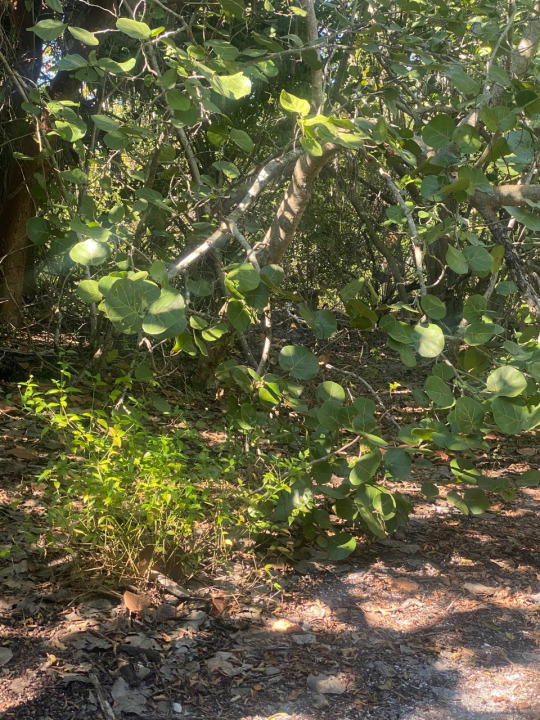
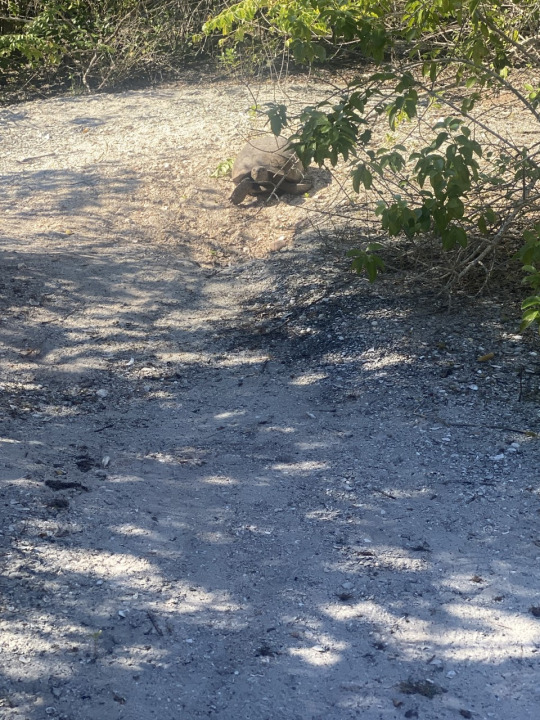
All of the plants in the butterfly garden are native to Florida. There are fire bushes which provide nectar for adult butterflies s well as larval host plants, which are both needed for a successful butterfly garden. The advantage of using native plants for a butterfly garden is that they do not disrupt the ecosystem. They have adapted for the sandy environment of Florida so the garden thrives much more, meaning they need less water and less maintenance in general. During our walk through the butterfly garden, I was able to take pictures of two different species of butterflies, which looked to be Zebra Helliconian, a black and yellow striped butterfly, as well as a queen butterfly, which bears similarities to the monarch butterfly.
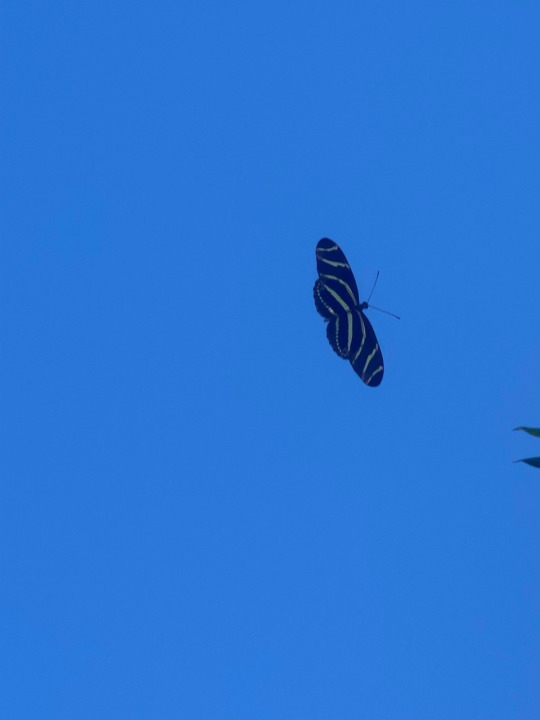
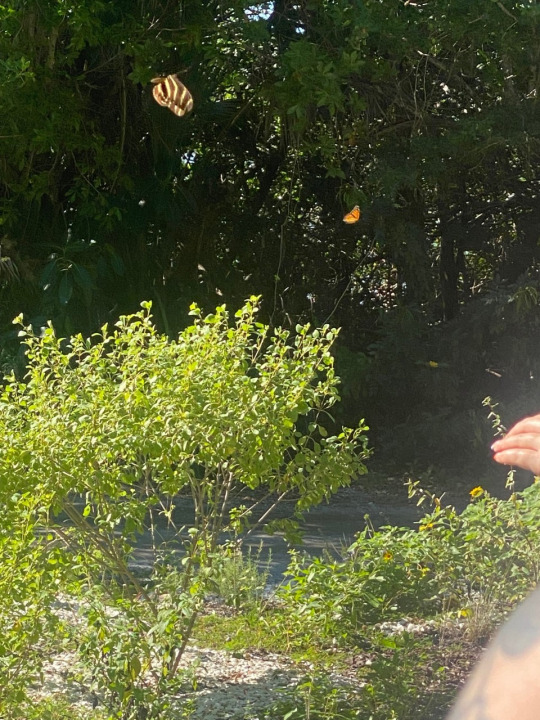
When at the beach, we were told to interact weith someone of our class that we were unfamiliar with. I talked with Makayla, who is a really fun person who I related to through our love of dogs. While at the beach, we found countless different kinds of shells, including a florida cone shell, jingle shells, calico clams, coquinas, scallops, angel wing, buttercup lucine, cerith, auger, a shark’s eye, and a modulus.
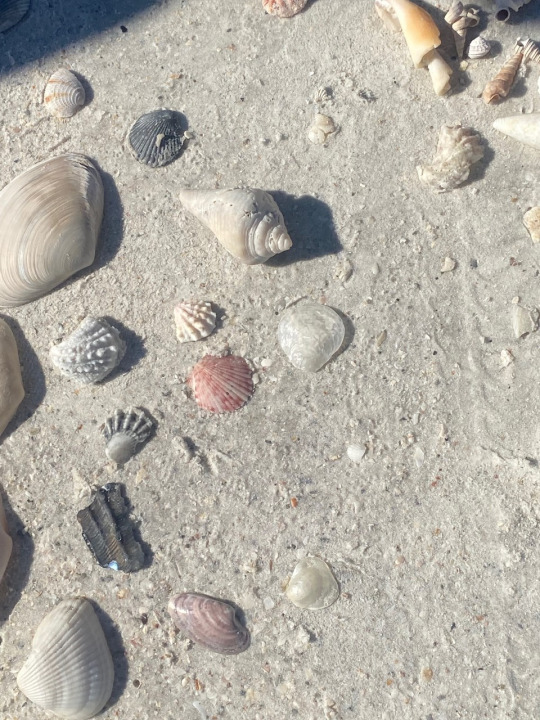
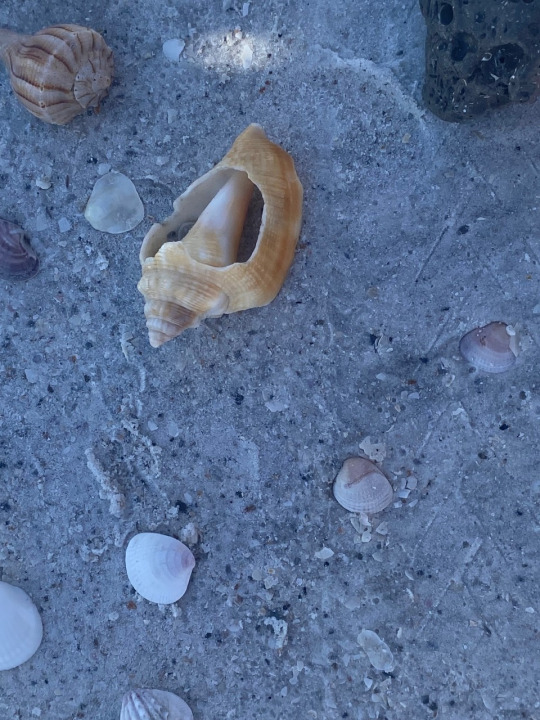
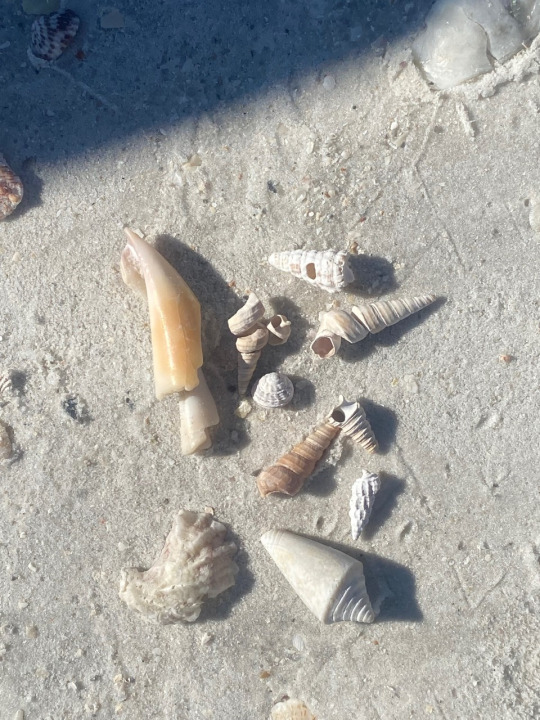
0 notes
Text
Journal 6
During the first section of “Awakening the Dreamer” we discussed the question of “Where are we?” which referred to where are we mentally on our individual journeys, as well as where are we together in this phase of humanity. The next section addressed “how did we get here?” which made me reflect on my past choices as well as think harder on my choices in the future. the next section addressed the topic of a new story, where we can look into the future to the questions that have yet to be asked. the section after that addresses the question of “where do we go from here?” I interpreted this section as a way to plan the future and look forward towards a brighter future.
My wow moment from this course was when we were asked to reflect on our personal feelings. Sustainability is so focused on the bigger picture and what we can give in order to improve the world’s conditions, but we forget that our individual feelings as people still matter; it doesn’t have to be one or the other when choosing sustainability. So many people fall for the trap that choosing to be sustainable and helping the environment means putting your personal feelings aside, when this is not the case. We can still work towards a brighter future while still taking into account our personal feelings as people.
Overall, this course is something I feel like everyone should go through in order to inspire the changemakers of tomorrow. We are always in need of more innovators and good people with good ideas that have the ability to make a difference in our lives, all they are lacking is the inspiration and motivation to do so.
0 notes
Text
Journal 5
During the course of the last few classes, we have discussed topics regarding the environment such as the actions that will be taken worldwide according to COPs and what actions we should take according to the Earth Charter. In the COPs, we discussed how for the first time, so many countries are actually agreeing to action against climate change and try and work towards the reduction of greenhouse gases. This inspired me and gave me hope that something will finally be done worldwide in order to address the countless environmental concerns we are facing. While discussing the Earth Charter, we all agreed that it had very valid points in which it brought up that in order to effectively solve the global environmental crisis we are facing, we all need to come together and take decisive action, for we are all one human race, one family. We all live on the same planet and rely on it for survival.
While reading the Earth Charter, I resonated with how it states that we are at a critical moment in Earth’s history; the decisions we make at this point in time will determine our future and the futures of our descendants. What we choose can go one of two ways: we can either be headed towards a future full of promise and life, or we can be headed towards a future of chaos and death.
The principles of the charter that I felt are most applicable today are the principles of ecological integrity. This is because I feel like the world is hyper focused on the actions that need to be taken in order to preserve the ecology and environment. Because of this, I feel like many are forgetting that compassion towards others, such as explained in the principles under the respect and care for the community of life, are essential in sustainable practices and our journey towards a brighter future. We need to be able to help each other up and make sure all of humanity is in a comfortable state that does not include homelessness, hunger, and many other things that affect the less fortunate of our society.
Forces that may hinder the full implementation of the Earth Charter, unfortunately, I believe will be the disagreement between people around the world. I feel our inability to agree on what needs to be done and the differing interests between the developed and developing worlds will be our downfall and prevent us from reaching the full extent of what we have the potential to accomplish. This can be overcome by much more active and effective communication. This is why I so fully support the COPs, because of how avidly countries all over the world are trying to effectively communicate on the actions that need to be taken.
My wow moment on the global efforts and the Earth Charter was how world leaders are finally actively working together in order to solve and hopefully reverse climate change. This is something I never thought I would see, mainly because I am so used to Global leaders saying that they are going to take measures in order to solve these problems and then never do. Being a part of the generation that might actually be and see change is very exciting to me and left me thinking “wow”.
0 notes
Text
Journal Entry 5
On Monday, November 1st, the class went on a field trip to the downtown Fort Myers area in order to see the amazing innovative architecture it uses in order to lessen its negative environmental impact as well as support the local community, while also seeing the things that are occurring that hurt the environment. The main focus of this field trip was to reflect on the amazing history in Downtown Fort Myers.
In the beginning of the tour, we were asked: What does a livable or sustainable city feel like to you? The class had many good answers including walkable, with green spaces, with renewable energy. I agree with all of this, but would also add that a sustainable city must also be enjoyable to live in. This is because if people do not find a city enjoyable to live in, they will not live in it and all of the efforts the city would’ve gone to in order to be sustainable would’ve been for nothing.
The downtown Fort Myers area encourages walking to get to places. Till the 60s it was normal to walk everywhere. After ww2 there was a lot of urban sprawl, which refers to the uncontrolled expansion of urban development. Urban sprawl means you need a car everywhere. At this point, we were asked, what has this city done to enhance its livability? The city has build walkways everywhere to encourage walking, building everything close to eachother, and to build living spaces above places such as diners and cafes.
We were then told of a fort in fort Myers. The fort was built in 1850 to support the few remaining seminoles in south west Florida. It included a hospital, bathing pier, and even a bowling alley.

Ft Myers is known for its cattle. This area had a lot of cattle and cattle ranchers.
-mWe we’re then asked, what does sense of lance mean to you? It was nice reflecting on a question we’ve reflected on in class countless times. Sense of place is where you’re safe, where you’re yourself, an emotional state where you feel connected to yourself.
We were then showed this place called Arcade Theatre. It is still used a lot today and you can just walk to it. It’s like a super target but on a much smaller scale. Like a mall.

The Art center is a repurposed building that used to be a federal building. Pillars are made of coral from the keys which is really expensive. The gold boxes in front were post boxes before the building was repurposed.

The Downtown Fort Myers Library is LEED certified. This means it is certified in Leadership in Energy and Environmental Design. What makes it LEED certified is its lower building costs, energy efficiency, bus transportation being available, and even a lot of bike racks being included to support biking. This library also gives The less fortunate accessibility to resources such as bathrooms, WiFi, books, etc.

After the Edison mall opened in 1965, it harmed this area. People preferred the air conditioned buildings that were more modern.
An interesting fact is that Fort Myers got funding for a yacht basin after they saw Sarasota have one. Boating and fishing is very prominent and a main asset to fort Myers, so a yacht basin just made sense.

The body of water is the Caloosahatchee river, means the calusa river river because Hatchee means river. It is impaired water which means it is murky and too contaminated for people to fish or be in. There is Excess nitrogen in these waters because of runoff from fertilizers and pesticides or leaking septic tanks and even boats.

The Downtown Fort Myers Park used to be really pretty. It’s been on construction for two years in order to increase the economy of Fort Myers but because of this, the space has been made less sustainable and less friendly to the less fortunate.

This field trip was very eye opening and educational, especially since I am not originally from the fort Myers area. It was amazing to see all of the history this place has to offer and how we can learn from it and apply principles to places everywhere.

0 notes
Text
Journal Entry 4
Echo- education concerns for hunger organization.

Echo is about the small farmers which is farmers who farm on 5 acres or less, and enables them to grow enough food so they can put their money in other places. About 1 billion people on earth are malnourished. A child dies of hunger related issues once every 12 seconds.
Echo also has has an intern program for college graduates, which is something that delights me for I would love to work somewhere like this after I graduate.
They are a demonstration farm, which means they show how to grow things differently in different world conditions.
Appropriate technology is simple ideas made from what is available to people locally that helps solve their problems. It means that places are using what they have and what they can get for what they need. Echo reduces hunger and improves the lives of the poor as well as providing practical solutions to help people help themselves and end the cycle of poverty.
After the introduction, we were led through the amazing scapes of Echo, the first being bamboo. Bamboo is a cash crop and is an excellent building material with the added benefit of being edible. They also contain water for one to drink if you’re ever stuck in the wilderness, although it may not taste the best. All the bamboo in echo is clumping bamboo. Bamboo need lots and lots of water.


Half a billion people drink bad untreated water and half of them will die from it. Some people need to travel 3.7 miles for 44 pounds of water 5 buckets every day. That would get pretty old pretty quick. Rolling bins make carrying water for those 3.7 miles easier. Groundwater is a good way to combat this as well. Groundwater is filtered to some degree, the deeper the water the better the water is, which is why deep wells are great options for clean water, since the deeper the well the better the water, although expensive to install. A shallow well is easy to dig and is inexpensive but it can go dry easily, especially in the dry season. An easy way to filter water is by crushing up a moringa seed and putting it in a jar of water. It can filter all the water up to 90%.


A Gravity fed water system is a good way to use minimal electricity for a water pump. Electricity brings it up but then you just need to open the valve for water.

A thing we saw that I thought was interesting was a brick maker. Clay bricks are 20% clay and 80% sand, making them less likely to crack. There’s also bottle bricks, which have trash stuffed into them and are used as bricks and are stronger than traditional bricks. This is an amazing way to use unrecyclable plastics that I hope become much more widely used.


Then we saw the large array of plants that Echo has, such as Shampoo ginger, which is used as soap and has a pleasant scent.

We also saw a system of ducks and fish. They have a cage of ducks that lay one egg a day every day for a year, which is a very good source of protein for places such as food deserts. Once they stop laying eggs they can be eaten. Under the ducks is a pond of tilapia fish. Tilapia fish don’t need a lot of oxygen in water they can be in standing water and like warmer water so this pond can be man made in the hottest conditions, such as Florida. The droppings of the ducks fall onto the lake which in turn feed the fish. They also have goats and pigs, which are adorable.

The site also has a neem tree. Neem tree and neem oil is good for teeth and gums to the point it’s used in toothpaste. If you Soak leaves of the tree through the night and you can use it as a natural pesticide and bug spray to keep the bugs off of you and your plants.
Another tree we saw was a Peanut butter tree. Fruit of it smells like peanut butter but it doesn’t taste like peanut butter.
We also saw that they have Cassava plants. 60-70% of world’s carbs come from cassava. This is because It’ll grow in little water and can be grown in harsh climates.
Moringa tree is a super plant. 7 times vitamin c of oranges. 4 times calcium of milk. These leaves are something everyone should have in their diet to be more healthy.
This field trip truly opened my eyes to all of the resources that are available to help the world. If these were to be more widely known they would get more funding and would be able to help even more people. I hope to work with places like these when I graduate and I hope to help as many people as echo does.
0 notes
Text
Journal Entry 3
On October 4th, we went of the CREW field trip, which we earned stands for Corkscrew Regional Ecosystem Watershed. The main parts of this hike we explored were the main entrance, the pine flatwoods, the seasonal marsh ecosystem, and the oak hammock.
In the entrance of CREW, we went over the three Ps: planet, people, and profit, as well as how each of these apply to CREW. It applies to the planet due to all of the conservation work that is being done. It applies to the people because of the water it holds and provides for us to be able to live our lives. It applies to profit because without the water places like these provide, Florida’s economy would crash due to its great dependence on water for places such as fisheries, beaches, and boating businesses.
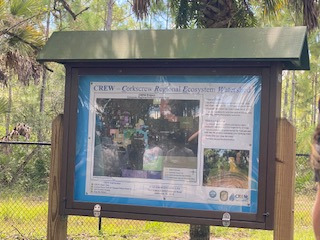
The first ecosystem we visited was the Pine Flatwoods, which was named due to it being an expanse of pine trees on a flat terrain. The soil in these pine flatwoods is made up mainly of sand, meaning it is very dry; just how pine trees like it. Because this is the driest part of CREW, it also means it is the highest point. This is because the water runs down, causing dryness. This is still beneficial to the pine trees and creates the perfect environment for them because they survive off of dry land, and would drown and get root rot if there was too much water in the soil. Fire is a necessary tool for pinecones to melt their sap and release their seeds for more pine trees to grow.
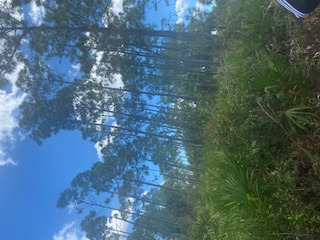
The second ecosystem we visited was the Seasonal Marsh ecosystem, which is named due to it not being present all year long, only mainly in the wet season. Marshes are the lowest point of CREW, which is why all of the water floods to it. The deepest part of a marsh is its center. In marshes, you will only find plants that do well submerged in water; you wont find any pine trees in these parts! They have many marshes, but their largest one is 5,000 acres and is beautiful.
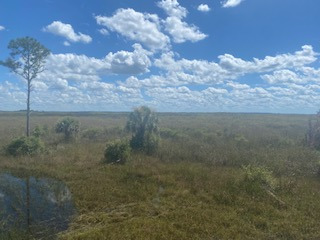
The third ecosystem we visited was the Oak Hammock, which is in higher altitude than the surrounding marshes and wetlands, but not as high as the pine flatwoods. This means that the soil here is damp, just right for oak trees to thrive. Because it is surrounded by wetlands, it acts sort of as a mini island. This is a prime place for mammals such as raccoons or rabbits to forage for food, which brings larger predators such as foxes or bobcats, creating a whole food chain. Unlike in pine flatwoods, if the oak hammock catches fire, the ecosystem would be destroyed and it would not grow back.
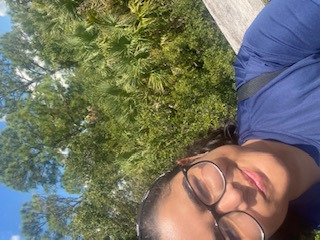
Throughout this hike, we encountered many different plants that out tour guide was kindly willing to explain to us. This was my favorite part of the entire day. I loved learning about all of the different plants that we can or cannot eat, such as the beauty berry, a purple berry that is edible, but does not taste good. Another one is wild sumac, which is not as pretty, but is edible and tastes much better with a nice sour tang to it. We also saw holly berries, which I unfortunately did not take a picture of, but are very caffeinated and are not edible. We saw pine lilies, which are some of the most beautiful (not edible) flowers I’ve seen. We also learned how to identify animal tracks of different animals such as different species of canines and felines, as well as bears and raccoon tracks. On the trail, we found dog tracks and learned how to identify them. I was also given lubber grasshopper to hold, which cured me of my fear of grasshoppers.
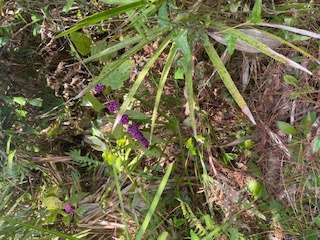
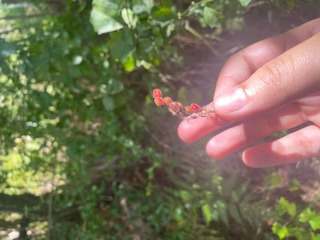
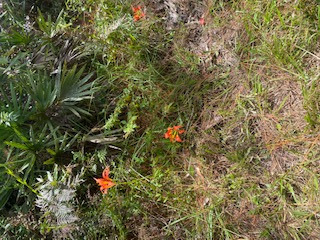
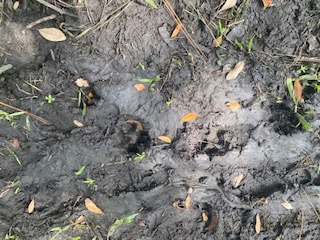
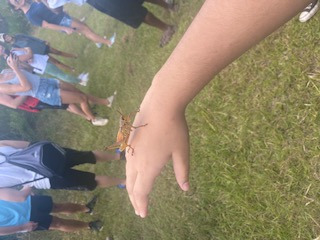
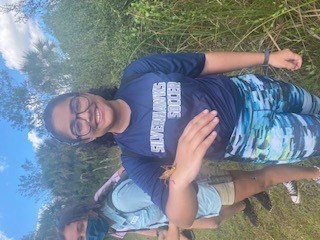
This trip made me extremely happy and opened me to this amazing place that I already cannot wait to go back to.
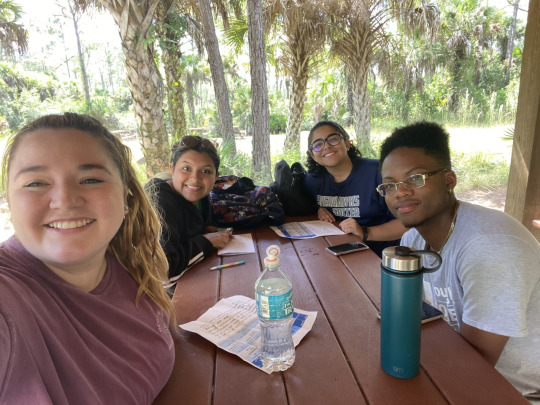
0 notes
Text
Journal Entry 2
On Monday, September 13th of 2021, our class took their first field trip. This field trip was on campus and was a nature walk around the natural reservations on the FGCU campus, as well as sights that display the sustainability efforts of FGCU. This field trip was broken into two parts, the display pf sustainability efforts with sights such as Seidler hall, Whitaker pond, and the central energy plant, and the nature trail itself with sights such as the slash pine ecosystem and the oak hammock. The first half of the tour started off at seidler hall, a LEED certified building. This stands for Leadership in Energy and Environmental Design certified. This means that Seidler hall has a lower average operating cost, used less construction waste, is a more durable building, supports the local economy, has greater resale value, improved air quality, and results in increased employee productivity. This building is the most sustainable in FGCU. Campus also uses solar trash compactors, which reduces the amount of space trash takes up due to it being compacted and limits the amount of times the trash has to be emptied. Another stop in the first half of this field trip was the central energy plant of FGCU, which holds approximately 23,000 tons of water. This water is how FGCU keeps its buildings cool; instead of relying on conventional AC, water is cooled to freezing temperatures and then run through pipe systems in the buildings in order to cool them down. Because of this much more sustainable method, water is the primary coolant on campus.
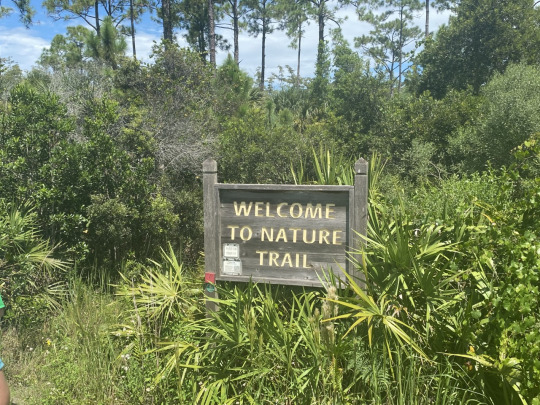
The second half of this field trip started off in the beginning of an FGCU nature trail. Walking down this trail, we first get to the Slash pine ecosystem, an area full of slash pine trees everywhere. While there, we were informed of how important fire is to the ecosystem of these trees, for it is how they spread their seeds. Fire also kills invasive plant species that take up the slash pine's resources. Another stop in the nature trail was oak hammock, which was also beautiful.
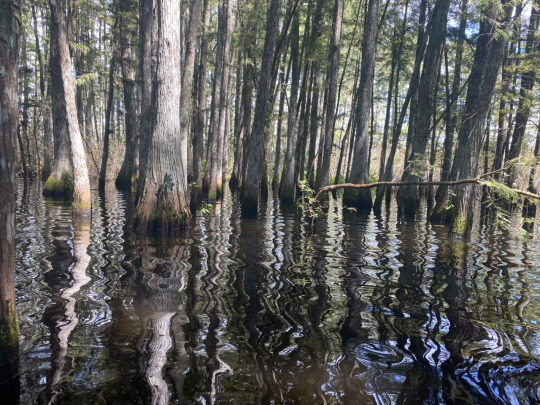
At the final stop of the nature trail, we were told to hug a tree, be silent, and listen carefully to the nature around us. The first thing that caught my attention was all of the insect sounds that surrounded us, but not long after, the sound my ears were most drawn to was the sound of the water. No matter how still in the water we were, we still managed to stir the water enough to make the sounds of beautiful little waves as they hit against the trees. This caused me to look up and see all of the trees, and how the water reflected on it, which to me is one of the most beautiful natural occurrences, to see water reflect light onto its surroundings. Due to this fieldtrip, I learned that there is beauty in the most benign things, if only you were to look up once in a while. I learned not everyone sees this nature trail the same way I do, for there were some classmates who saw it as nothing more than a swamp and could not wait to leave. If I were to come here alone, I feel a sense of place in this clearing, and I am in love with the beauty you can see in every corner. I hope to be back soon.
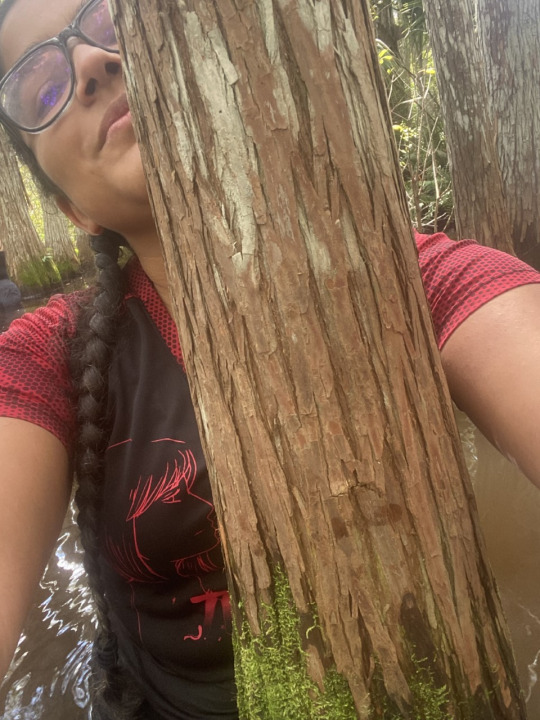
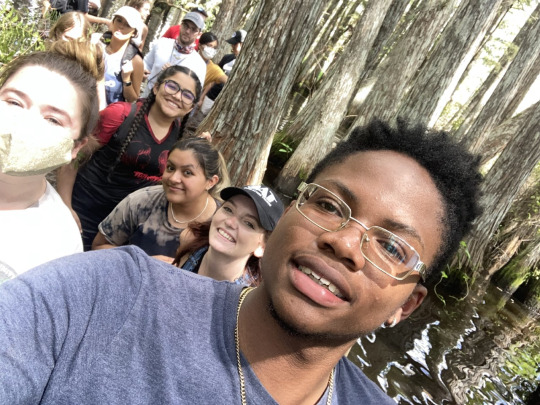
0 notes
Text
Journal Entry 1
My name is Nelymar Zayas, but I go by Nely for it is easier for people to pronounce; even though I do not think my name is that difficult to pronounce (nel-ee-mahr), many people seem to struggle with it. My declared major is environmental engineering. I chose this major because it is my dream to apply modern technology to environmental issues the planet has faced for so long. When I first heard of the Colloquium class and had it vaguely explained to me, I believed it was going to be another class about being educated about the environment around us. I did not think too much about it for due to my major, I knew I was going to encounter many classes simply about explaining all of the environmental issues we presently face and will continue to face if actions are not taken in order to slow and eventually cease all of these problems around us. That is all I thought of Colloquium, until I attended the class for the first time. I quickly realized the class was going to be much more than just the vague explanation of all of the environmental issues we face and was going to include many hands on learning opportunities with all of the field trips we will be taking during this course, as well as the service-learning opportunities we will be seeking. I expect to not only be learning of the problems the world faces but actively discussing the actions we as individuals can take in order to lessen the effects of problems such as global warming, deforestation, water pollution, etc. I am excited to learn these things as well as to connect them to my personal life and make changes to the way I live with the material I hope to learn in this class. I am also excited to connect the information I will learn in Colloquium to my major of environmental engineering, for as an environmental engineer my main concern will be to protect the environment and put it first at all costs. I am excited to learn material that will help me become a better and more effective environmental engineer, as well as be able to pass on that knowledge to colleagues, friends, and family. My goal for this course is to be able to expand my sense of self with the information I will receive, to learn things I can take with me for the rest of my professional career, as well as be applied to my personal life. I am excited to discuss with classmates and the professor all of the actions we can take to keep the world just a little safer and a little greener than it was before we left it.
1 note
·
View note